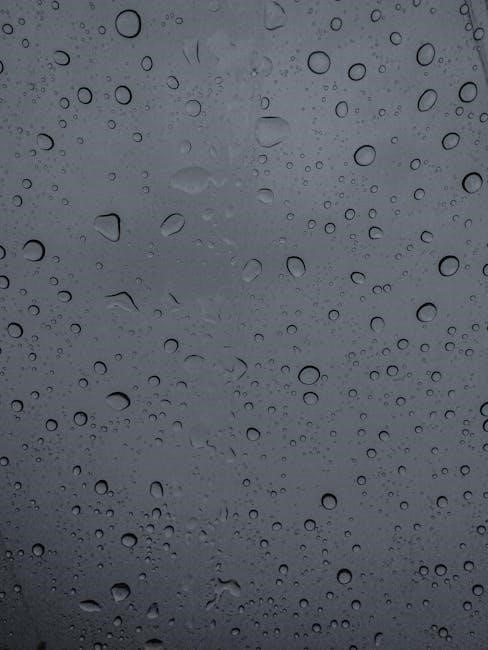Dry bulb, wet bulb, and relative humidity are essential concepts in understanding air properties․ Dry bulb temperature measures air temperature, while wet bulb temperature reflects evaporative cooling․ Relative humidity indicates moisture levels, crucial for thermal comfort and air quality assessments․
1․1 Understanding the Basics of Dry Bulb Temperature
Dry bulb temperature measures the air temperature using a thermometer shielded from moisture․ It reflects the actual heat felt by the human body․ Unlike wet bulb temperature, it is not affected by evaporation․ This measurement is crucial for calculating relative humidity and understanding air properties․ Dry bulb temperature is often plotted on psychrometric charts to analyze air conditions effectively․
1․2 What is Wet Bulb Temperature?
Wet bulb temperature is measured using a thermometer wrapped in a wet cloth, creating evaporative cooling․ It reflects the lowest temperature achievable by evaporation, influenced by air temperature and humidity․ Wet bulb temperature is always lower than or equal to dry bulb temperature, except in saturated air․ This measurement is vital for assessing heat stress and thermal comfort in HVAC and meteorological applications, providing insights into how humidity affects cooling processes․

1․3 Defining Relative Humidity
Relative humidity (RH) is the percentage of water vapor in the air compared to the maximum it can hold at a given temperature․ It is calculated using dry bulb and wet bulb temperatures, with higher RH indicating more moisture․ RH is crucial for understanding comfort levels, as high humidity can impede sweat evaporation, while low humidity may cause dryness․ RH charts and tables are essential tools for determining these values accurately in various applications․
The psychrometric chart graphically represents air properties, including dry bulb temperature, wet bulb temperature, and relative humidity․ It is a vital tool for HVAC engineers and meteorologists to analyze and design air conditioning systems, understand humidity ratios, and determine dew point temperatures․ The chart is widely used for optimizing thermal comfort and energy efficiency in various applications․ The psychrometric chart is crucial in HVAC for designing efficient systems and ensuring indoor air quality․ In meteorology, it aids in weather forecasting by analyzing humidity and temperature․ It helps determine dew points, enthalpy, and humidity ratios, which are essential for predicting weather patterns and understanding air conditions․ The chart’s comprehensive data enables professionals to make accurate calculations, ensuring optimal performance in both fields․ Its versatility makes it indispensable for practical applications․ The psychrometric chart includes dry bulb temperature, wet bulb temperature, relative humidity, and dew point․ It also features enthalpy and humidity ratio, essential for analyzing air properties․ These components help visualize relationships between temperature, humidity, and air quality, making it a vital tool for HVAC system design and meteorological analysis․ The chart’s axes typically plot dry bulb temperature and humidity ratio, with curves for relative humidity and wet bulb temperature․ Dry bulb temperature measures air temperature directly, while wet bulb temperature reflects evaporative cooling․ The difference between them is crucial for determining relative humidity․ Dry bulb temperature is measured using a standard thermometer, reflecting the air’s actual heat; Wet bulb temperature, in contrast, is measured by wrapping the bulb in a moistened wick, allowing evaporation to lower the reading․ This difference is fundamental for calculating relative humidity and understanding the air’s moisture content, especially in HVAC and meteorological applications․ Dry bulb and wet bulb temperatures are critical for determining relative humidity․ The difference between these temperatures helps estimate moisture levels․ By using psychrometric charts or conversion tables, professionals can calculate relative humidity, which is essential for HVAC systems and weather forecasting․ Accurate measurements ensure optimal thermal comfort and prevent moisture-related issues in various applications․ Relative humidity conversion tables and charts are tools used to determine relative humidity from dry bulb and wet bulb temperatures․ They provide quick reference for professionals, ensuring accurate calculations․ Tables enable quick conversion of dry bulb and wet bulb temperatures to relative humidity․ By identifying the dry bulb temperature and the difference between dry and wet bulb temperatures, users can find the corresponding relative humidity at their intersection in the table․ This method ensures accurate and efficient calculations, crucial for applications in HVAC and meteorology․ Relative humidity charts are graphical tools that display the relationship between dry bulb and wet bulb temperatures with relative humidity․ To interpret them, locate the dry bulb temperature on the x-axis and the wet bulb temperature on the y-axis․ The intersection point indicates the relative humidity percentage․ These charts are widely used in HVAC and meteorology for accurate humidity assessments and system design․ Dry bulb, wet bulb, and relative humidity data are crucial in HVAC for system design and in meteorology for weather forecasting, ensuring thermal comfort and safety․ In HVAC systems, dry bulb, wet bulb, and relative humidity data are vital for optimizing air quality․ These measurements help design and control systems to maintain thermal comfort, prevent moisture damage, and reduce energy consumption․ By analyzing these parameters, HVAC engineers ensure efficient heating, cooling, and humidity control, creating healthier indoor environments․ This data is also used to calculate dew point and enthalpy, essential for system performance․ Meteorologists use dry bulb, wet bulb, and relative humidity data to analyze weather patterns․ These measurements help predict precipitation, dew point, and heat index, crucial for accurate forecasts․ By monitoring humidity levels, meteorologists can assess atmospheric stability and predict severe weather events․ This data is also used in climate models to understand long-term trends, ensuring better preparedness for extreme weather conditions and improving public safety through timely warnings․ The chart is vital for determining dew point temperature, calculating enthalpy, and assessing humidity ratios․ It aids in evaluating heat index and thermal comfort, essential for HVAC system design and meteorological forecasting․ By analyzing dry bulb and wet bulb temperatures, professionals can optimize cooling systems, predict weather patterns, and ensure energy efficiency in various industrial and environmental applications․ The dry bulb-wet bulb temperature chart is instrumental in determining dew point temperature, a critical factor in assessing air moisture․ By comparing dry bulb and wet bulb temperatures, the chart allows precise calculation of dew point, which is the temperature at which air becomes saturated with water vapor․ This measurement is vital for understanding humidity levels, predicting fog formation, and ensuring accurate thermal comfort in HVAC systems and meteorological applications․ High dew point temperatures indicate high moisture content, impacting human comfort and industrial processes․ The psychrometric chart is a vital tool for calculating enthalpy and humidity ratio, which are essential for HVAC system design․ Enthalpy represents the total energy of air, combining sensible and latent heat, while humidity ratio indicates the mass of water vapor per unit mass of dry air․ By locating the intersection of dry bulb and wet bulb temperatures on the chart, professionals can determine these values accurately, ensuring optimal system performance and thermal comfort in various applications․ Wet bulb temperature accuracy can be affected by airspeed and radiation․ Relative humidity charts may have limitations at lower temperatures, impacting dew point calculations․ Several factors influence the precision of wet bulb temperature measurements․ Airspeed variations can alter evaporation rates, while radiation from surrounding surfaces may heat the bulb․ Humidity levels, especially at lower values, can also affect accuracy․ Additionally, improper sensor placement or maintenance, such as dirty or damaged wicks, can lead to erroneous readings․ These factors must be controlled to ensure reliable data for psychrometric calculations․ Relative humidity charts have limitations, including accuracy dependence on precise dry and wet bulb temperature measurements․ Small errors in these readings can lead to significant RH inaccuracies․ Additionally, charts are pressure-specific, making them less reliable at high altitudes․ They also assume air behaves as an ideal gas, which may not hold under extreme conditions․ Interpolation between chart values can introduce estimation errors, further reducing precision in critical applications․ These constraints must be considered for reliable results․ The dry bulb, wet bulb, and relative humidity chart is a vital tool for understanding air properties․ It aids in calculating thermal comfort, dew point, and enthalpy, essential for HVAC and meteorology․ Accurate measurements ensure reliable results, making it indispensable for practical applications and precise weather forecasting․ The psychrometric chart is a fundamental tool for analyzing air properties, including dry bulb, wet bulb, and relative humidity․ It provides critical data for HVAC systems and meteorological studies․ Understanding these concepts helps in determining thermal comfort, dew point, and enthalpy․ Accurate measurements ensure reliable results, making the chart indispensable for practical applications․ It bridges theory and practice, offering insights into air behavior under various conditions․ Accurate measurements of dry bulb, wet bulb, and relative humidity are crucial for reliable results in HVAC and meteorology․ Precise data ensures optimal system performance and safety․ Inaccuracies can lead to inefficiencies or hazards, such as miscalculating heat stress risks․ Using psychrometric charts aids in maintaining thermal comfort and preventing equipment failures, highlighting the necessity of precise measurements in real-world applications․ Recommended textbooks and online resources provide detailed psychrometric charts and calculations․ PsychroLib and similar tools offer comprehensive libraries for precise humidity and temperature analysis, ensuring accurate results․ Key resources include textbooks on psychrometrics and online tools like PsychroLib, offering detailed charts and formulas․ Lecture notes and PDF guides provide practical examples for calculating relative humidity from dry and wet bulb temperatures, ensuring accurate and efficient learning for students and professionals alike․ Online tools like PsychroLib and interactive psychrometric charts enable precise calculations of relative humidity, wet bulb, and dry bulb temperatures․ These resources offer dynamic visualizations and real-time computations, aiding engineers and researchers in HVAC and meteorology․ They simplify complex psychrometric analysis, making them indispensable for accurate and efficient results; Advanced psychrometry delves into complex air property calculations, including enthalpy, humidity ratio, and wet-bulb temperature dynamics․ It explores thermodynamic principles and their applications in HVAC systems, meteorology, and industrial processes․ Topics also cover psychrometric chart interpretations for precise air quality modeling and cooling system designs․ Recent advancements focus on integrating psychrometry with computational tools, enabling accurate predictions for climate control and energy efficiency in various environments․ These studies are vital for optimizing thermal comfort and sustainability in diverse applications․ Recent studies focus on enhancing psychrometric chart accuracy and integrating real-time data for precise humidity and temperature measurements․ Innovations include advanced sensors and AI-driven models to predict humidity ratios and wet-bulb temperatures․ Researchers are also exploring the impact of climate change on humidity levels and thermal comfort, emphasizing the need for updated psychrometric standards․ These advancements aim to improve HVAC efficiency and weather forecasting accuracy globally․
The Psychrometric Chart: A Comprehensive Overview
2․1 Importance of the Psychrometric Chart in HVAC and Meteorology
2․2 Key Components of the Psychrometric Chart

Dry Bulb and Wet Bulb Temperature Relationship
3․1 How Dry Bulb and Wet Bulb Temperatures Differ
3․2 The Role of Dry Bulb and Wet Bulb Temperatures in Calculating Relative Humidity
Relative Humidity Conversion Tables and Charts
4․1 Using Tables to Convert Dry Bulb and Wet Bulb Temperatures to Relative Humidity
4․2 How to Read and Interpret Relative Humidity Charts
Applications of Dry Bulb, Wet Bulb, and Relative Humidity Data
5․1 Industrial Applications in Heating, Ventilation, and Air Conditioning (HVAC)
5․2 Meteorological Applications and Weather Forecasting
Practical Uses of the Dry Bulb-Wet Bulb Temperature Chart
6․1 Determining Dew Point Temperature
6․2 Calculating Enthalpy and Humidity Ratio
Limitations and Considerations
7․1 Factors Affecting the Accuracy of Wet Bulb Temperature Readings
7․2 Limitations of Using Relative Humidity Charts

8․1 Summary of Key Concepts
8․2 The Importance of Accurate Measurements in Practical Applications

References
9․1 Recommended Textbooks and Resources
9․2 Online Tools and Software for Psychrometric Calculations

Further Reading
10․1 Advanced Topics in Psychrometry
10․2 Recent Research and Developments in the Field